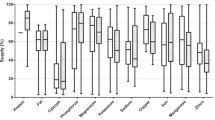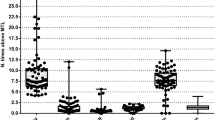Abstract
There is little information on the levels of chemical elements in pet food considering the dietary requirements as well as risk assessment of toxicity. This study aimed to determine the essential and toxic elements in dry and canned foods for dogs and cats and estimate their daily intake. We compared the levels of the chemical elements between the dry and wet (canned) food to the levels recommended by the Association of American Feed Control Officials (AAFCO) and the European Pet Food Industry Federation (FEDIAF) and the maximum tolerable level proposed by European Commission (EC). In addition, the estimated daily intake (EDI) for each one of the elements through food was calculated. Seventy-six dry food samples (dogs n = 62 and cats n = 14) from 43 brands and 12 canned foods (dogs n = 6 and cats n = 6) from 5 brands, were purchased from Brazilian supermarkets. Mean levels of all essential elements reached the minimum level recommended by AACFO. Selenium levels were very close to the maximum limit proposed by AAFCO. Besides, the iron concentrations in canned (moist) food were statistically higher than in dry food and its EDI for cats (54 mg/day × kg body weight) exceeded the maximum limit recommended by FEDIAF. Regarding the toxic metals, the concentrations of mercury and cadmium, in dry and canned food, were considerably higher than the maximum tolerable level proposed by EC. Overall, the results show that levels of essential elements are in agreement with the nutrient requirement. On the other hand, mercury and cadmium in pet food are an issue of concern.
Similar content being viewed by others
References
AAFCO, Association of American Feed Control Officials (2003) Non-pet food: label design & format guide. AAFCO, Oxford
Ambrose AM, Larson PS, Borzelleca JF, Hennigar GR Jr (1976) Long term toxicologic assessment of nickel in rats and dogs. J Food Sci Technol 13:181–187
APPA, American Pet Products Association (2013). http://www.americanpetproducts.org/pubs_survey.asp. Accessed June 2018
Byron WR, Bierbower GW, Bouwer JB, Hansen WH (1967) Pathologic changes in rats and dogs from two-year feeding of sodium arsenite or sodium arsenate. Toxicol Appl Pharmacol 10:132–147
Charbonneau SM, Munro IC, Nera EA, Armstrong FA, Willes RF, Bryce F, Nelson RF (1976) Chronic toxicity of methylmercury in the adult cat. Interim Rep Toxicol 5:337–349
Costa SSL, Pereira ACL, Passos EA, Alves JPH, Garcia CAB, Araujo RGO (2013) Multivariate optimization of an analytical method for the analysis of dog and cat foods by ICP OES. Talanta 108:157–164
Dean BS, Oehme FW, Krenzelok EP, Griffith GR, Hines RH (1996) Iron complexation with oral deferoxamine in a swine model. Vet Hum Toxicol 38:96–98
Duran A, Tuzen M, Soylak M (2010) Trace element concentrations of some pet foods commercially available in Turkey. Food Chem Toxicol 48:2833–2837
EC, European Commission (2012) Directive 2002/32/EC of the European Parliament and of the Council of 7 May 2002 on undesirable substances in animal feed. Off J L140:1–10 (30.5.2002, as last amended by Commission Regulation (EU) Official Journal 1)
FEDIAF, European Pet Food Industry Federation (2011) Nutritional Guidelines for complete and complementary pet food for cats and dogs. http://www.fediaf.org/self-regulation/nutrition.html. Accessed Jun 2018
Fleming AJ (1982) The toxicity of antimony trioxide. Sponsored by E.I. Du Pont de Nemours and Co., Wilmington DE. OTS215027
Furr AK, Bache CA, Gutenmann WH, Pakkala IS, Lisk DJ (1976) Element and chlorinated hydrocarbon content of commercial pet foods. Cornell Vet 66:513–527
GBC, Government of British Columbia (1996) Animal weights and their food and water requirements, Resource document. ministry of environment, lands and parks. http://www.env.gov.bc.ca/wat/wq/reference/foodandwater.html#table2. Accessed Jun 2018
Goehring TB, Palmer IS, Olson OE, Libal GW, Wahlstrom RC (1984) Toxic effects of selenium on growing swine fed corn-soybean meal diets. J Anim Sci 59:733–737
González-Martín I, Alvarez-García N, González-Pérez C, Villaescusa-García V (2006) Determination of inorganic elements in animal feeds by NIRS technology and a fibre-optic probe. Talanta 69:711–715
Grotto D, Carneiro MF, de Castro MM, Garcia SC, Barbosa-Junior F (2018) Long-term excessive selenium supplementation induces hypertension in rats. Biol Trace Elem Res 182:70–77
IBGE, Instituto Brasileiro de Geografia e Estatística (2013) Pesquisa Nacional de Saúde, 2013: acesso e utilização dos serviços de saúde, acidentes e violências: Brasil, grandes regiões e unidades da federação. http://www.ibge.gov.br. Accessed Jun 2018
Ikem A, Egiebor NO (2005) Assessment of trace elements in canned fishes (mackerel, tuna, salmon, sardines and herrings) marketed in Georgia and Alabama (United States of America). J Food Compos Anal 18(8):771–787
Jomova K, Valko M (2011) Advances in metal-induced oxidative stress and human disease. Toxicology 283:65–87
Katz AC, Frank DW, Sauerhoff MW, Zwicker GM, Freudenthal RI (1984) A 6-month dietary toxicity study of acidic sodium aluminium phosphate in beagle dogs. Food Chem Toxicol 22:7–9
Kelly DG, White SD, Weir RD (2013) Elemental composition of dog foods using nitric acid and simulated gastric digestions. Food Chem Toxicol 55:568–577
Loeser E, Lorke D (1977) Semichronic oral toxicity of cadmium. 2. Studies on dogs. Toxicology 7:225–232
Lovásová E, Rácz O, Cimboláková I, Nováková J, Dombrovský P, Ništiar F (2013) Effects of chronic low-dose cadmium exposure on selected biochemical and antioxidant parameters in rats. J Toxicol Environ Health A 76:1033–1038
Maynard EA, Down WL, Hodge HC (1953) Oral toxicity of uranium compounds. In: Voegtlin C, Hodge HC (eds) Pharmacology and toxicology of uranium compounds. McGraw-Hill, New York, pp 1221–1369
Morel FM, Kraepiel AM, Amyot M (1998) The chemical cycle and bioaccumulation of mercury. Ann Rev Ecol Syst 29(1):543–566
Nardi EP, Evangelista FS, Tormen L, SaintPierre TD, Curtius AJ, de Souza SS, Barbosa F Jr (2009) The use of inductively coupled plasma mass spectrometry (ICP-MS) for the determination of toxic and essential elements in different types of food samples. Food Chem 112:727–732
Neiger RD, Osweiler GD (1992) Arsenic concentrations in tissues and body fluids of dogs on chronic low-level dietary sodium arsenite. J Vet Diagn Investig 4:334–337
NRC, National Research Council (2005) Mineral tolerance of animals: second revised. Committee on Minerals and Toxic Substances in Diets and Water for Animals, Washington, DC (8 1/2 × 11)
Pettersen JC, Hackett DS, Zwicker GM, Sprague GL (1990) Twenty-six week toxicity study with KASAL® (basic sodium aluminum phosphate) in beagle dogs. Environ Geochem Health 12:121–123
Priego-Capote F, Luque de Castro MD (2004) Dynamic ultrasound-assisted leaching of essential macro and micronutrient metal elements from animal feeds prior to flame atomic absorption spectrometry. Anal Bioanal Chem 378:1376–1381
Rahman MA, Hasegawa H, Lim RP (2012) Bioaccumulation, biotransformation and trophic transfer of arsenic in the aquatic food chain. Environ Res 116:118–135
Rallis T, Spais AG, Papasteriadis A, Agiannidis A, Leondidis S (1989) Iron toxicity in sheep. J Trace Elem Electrol Health Dis 3:131–137
Rifkin J, Miller MD (2014) Copper-associated hepatitis in a Pembroke Welsh corgi. Can Vet J 55(6):573–576
Todd SE, Thomas DG, Bosch G, Hendriks WH (2012) Selenium status in adult cats and dogs fed high levels of dietary inorganic and organic selenium. J Anim Sci 90:2549–2555
Tuzen M, Soylak M (2007) Evaluation of trace element contents in canned foods marketed from Turkey. Food Chem 102:1089–1095
Valko M, Morris H, Cronin MTD (2005) Metals, toxicity and oxidative stress. Curr Med Chem 12:1161–1208
WHO, World Health Organization (1998) Copper: environmental health criteria 200. World Health Organization, Geneva
Zicker CS (2008) Evaluating pet foods: how confident are you when you recommend a commercial pet food? Top Companion Anim Med 23:121–126
Acknowledgements
The authors thank Fundação de Amparo à Pesquisa do Estado de São Paulo (FAPESP) and Conselho Nacional de Desenvolvimento Científico e Tecnológico (CNPq) for financial support.
Author information
Authors and Affiliations
Corresponding author
Ethics declarations
Conflict of interest
The authors declare that they have no conflict of interest.
Rights and permissions
About this article
Cite this article
Paulelli, A.C.C., Martins, A.C., de Paula, E.S. et al. Risk assessment of 22 chemical elements in dry and canned pet foods. J Consum Prot Food Saf 13, 359–365 (2018). https://doi.org/10.1007/s00003-018-1178-5
Received:
Accepted:
Published:
Issue Date:
DOI: https://doi.org/10.1007/s00003-018-1178-5




